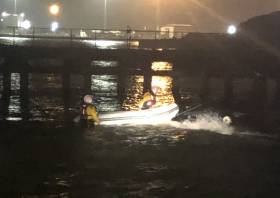Displaying items by tag: Cromarty Firth
Safehaven Marine’s latest deliveries this month include a second pilot boat for Scotland’s Port of Cromarty Firth and a specialised vessel for port operations in Southampton.
Williams Shipping have taken delivery of an Interceptor 48 for crew transfer operations and pilot transfers in the Port of Southampton on the south coast of England.
Willfreedom is the Youghal-based performance boat builder’s 51st pilot boat delivered thus far. It’s powered by a pair of Scania DI13 500hp engines for an operational speed of 25 knots and boats remarkable fuel economy, using as little as 50l/phr from each engine at 20 knots.
 Willfreedom is Safehaven Marine’s 51st pilot boat delivered thus far | Credit: Safehaven Marine
Willfreedom is Safehaven Marine’s 51st pilot boat delivered thus far | Credit: Safehaven Marine
 Willfreedom’s central helm position is fitted with a full array of Raymarine navigation equipment | Credit: Safehaven Marine
Willfreedom’s central helm position is fitted with a full array of Raymarine navigation equipment | Credit: Safehaven Marine
Inside, the central helm position for optimal vessel control is fitted with a full array of Raymarine navigation equipment, while the Grammer shock mitigation seating ensures crew and passenger comfort, as does the full interior climate control.
Elsewhere, Safehaven’s 50th pilot vessel is Balblair, which joins Dalmore (delivered in 2019) as the second order from the Port of Cromarty Firth.
This variation is powered by twin Volvo D13 500hp engines with a “very economical” 25 knots operational speed, as well as a a full array of Furuno navigation equipment and full live-aboard facilities in the spacious lower forward cabin.
 Balblair alongside sister pilot boat Dalmore at the Port of Cromarty Firth | Credit: Safehaven Marine
Balblair alongside sister pilot boat Dalmore at the Port of Cromarty Firth | Credit: Safehaven Marine
Safehaven Marine’s managing director Frank Kowalski said: “A repeat order from a port is always extremely satisfying as it demonstrates the client’s full satisfaction with the boat and his confidence in our company, especially as the contract for Balblair came in the middle of a global pandemic.”
Invergordon RNLI’s volunteer lifeboat crew launched at 8.36pm last night (Saturday 23 November) to reports of a vessel with no power drifting towards oil rigs in the Cromarty Firth.
The all-weather Trent class lifeboat Douglas Aikman Smith made best speed to the location of two anchored oil rigs — iconic fixtures in the firth — with the two male occupants of the stricken RIB signalling their location by head torch.
After suffering engine trouble shortly after setting off from Nigg, the RIB had drifted a considerable distance with the incoming tide, coming close to the unmanned structures before the lifeboat arrived on scene five minutes after launching.
With no medical issues and the casualties assessed, the lifeboat took the 10ft RIB under tow to Nigg slipway to be recovered and escorted its two crew safely ashore in the lifeboat’s XP boat.
























































